WHO is blunt in its assessment: ageism is omnipresent, affecting everybody, everywhere even from an early age. Ageism starts in childhood and, as time passes, it is reinforced and internalized. According to WHO, ageism can be defined in terms of stereotypes, prejudices, and discrimination that undermine the way we think, feel, and act toward other people and toward ourselves. Ageism not only affects the way we interact with the world around us (often self-limiting opportunities) but also highly affects the labour market. And the tech industry does not escape this scourge. Unfortunately, according to CWJobs’ report, tech and IT workers start feeling too old and worrying about their future work prospects by the age of 38.
What is ageism?
Similar to racism or sexism, ageism is a form of oppression that seriously affects people’s health and general well-being, leading to social isolation, financial insecurity, poorer mental and physical health, etc. The main difference is that ageism is not fully perceived in its real, negative dimension.
Ageism affects old and young people alike and extends to many institutions and social sectors, including the workplace. According to a report published by WHO in 2021, there are several factors that increase the risk of becoming a victim of ageism: working in specific occupational sectors (e.g. hospitality, high-tech, etc.), being old and/or care-dependant, or having a low healthy life expectancy.
A report published in 2020 by SeniorLiving.org highlights the fact that one in five +40 workers experience age-based discrimination in the U.S. Even though there are various laws that bar age-based discrimination, (e.g. The Age Discrimination in Employment Act in the U.S. or The Equality Act 2010 in the U.K.), ageism has turned into a pressing global issue that needs to be addressed.
According to the same source, ageism in the technology industry occupies the 5th position, closely following the education industry:
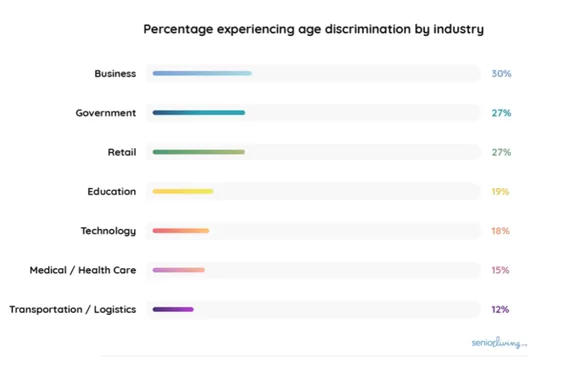
Ageism at the workplace manifests in various ways. However, it stands out that 52% of the respondents over 60 have been passed up for job-related opportunities.
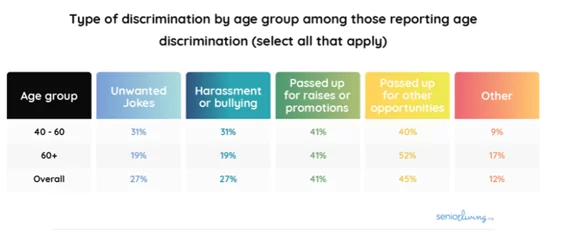
Ageism at the workplace in the tech industry
The prevalence of old ageism in the tech industry is more than likely related to the fact that innovation lies at the core of this fast-paced, ever-evolving industry. This gave birth to the belief that older people find it difficult to keep up with technological progress.
According to a survey sent out by CWJobs, a UK-based tech recruitment website, to 2,000 workers and 250 people who work in the tech and IT sectors, 41% of the IT and tech-sector workers have experienced age discrimination in the workplace. The survey also reveals that only 27% of the workers across the other industries have experienced ageism.
The most striking aspect of the survey is the age at which the respondents started to experience ageism:
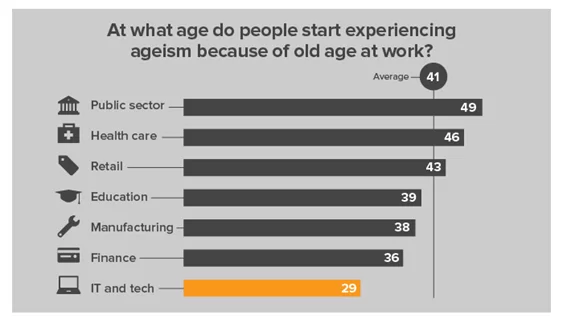
The survey also highlights the most common ageist phrases:
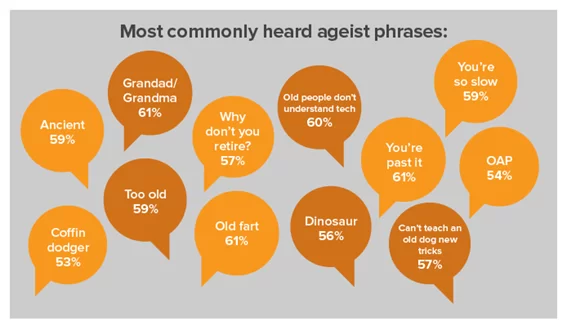
Even if, most of the time, these phrases are said jokingly, they are still an indicator of how old ageism in the tech industry is taking a toll on workers’ health, well-being, and motivation.
Other examples of old ageism in the tech industry include:
- Reluctance to hire people over a certain age
- Policies that favour younger groups
- Age-related bullying and/or harassment
- Unnecessary and hurtful ageist jokes
- Fewer training and/or promotion opportunities
- Exclusion from corporate social events and activities
Why does ageism actually hurt the tech industry?
If you think of it, it’s common sense. While it is true that all industries are built upon economic principles, it is also true that giving up to certain demographics when developing new tech products may lead your company to miss valuable potential customers. Older workers not only bring to the table their expertise and knowledge but also valuable insights that younger workers don’t have access to. Let’s think for a moment about open banking, social networks, or content platforms. Whether we like them or not, whether we are ready for them or not, they are here to stay. However, different users have different needs. Failing to address the needs of older end-users (let’s say +60) directly translates into missing a significant target market. As the prevalence of tech services and products increases and older users need to embrace digital solutions, the problem of ageism in the tech industry will become more and more pressing. Age diversity at the workplace is – after all – a way of guaranteeing ageless technological inclusion of both workers and end-users.
Additionally, older employees tend not only to commit to their job for a longer period of time but also bring to the table problem-solving, decision-making, time management, and improved communication skills.
How to combat ageism in the tech industry
Age discrimination is present in virtually all industries. However, as demonstrated above, it is prevalent in the tech industry, affecting older employees’ chances of getting and keeping a job and diminishing their chances of getting promoted. However, preventing ageism in the workplace is possible if the right strategies are adopted. Here are some steps that employers can take:
Promote multigenerational learning within your business
Fostering the cooperation between older workers and junior employees is a fruitful strategy that will bring together the age-forged professional experience and native digital skills. While it is true that young employees are naturally technically fluent and adapt to change rapidly, the older workforce has a set of abilities and skills that take a long time and professional experience to develop. Fostering this skills exchange will not only allow older workers to become tech-savvy but will also provide younger generations with a valuable experience-forged set of skills and knowledge. This strategy will also enhance non-discriminatory social interaction.
Make sure your employment discrimination policy includes ageism
Clearly state the necessary process to report incidents at all levels (e.g. among co-workers, between an employee and his/her superior, etc.)
Implement regular diversity reporting
Through this initiative, you will make sure that your business’ workforce is more diverse and inclusive. As TalentLyft points out, diversity in the workplace comes with a series of advantages that no company should overlook:
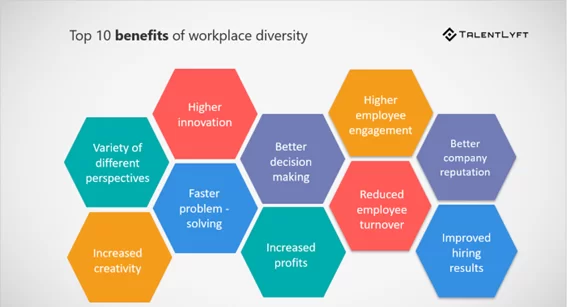
Use adequate language in job descriptions
Sometimes, the language that companies use within their job descriptions may be age-discriminatory. Instead of describing the type of person needed for the job, the job description and application process should focus on the necessary skills the job requires.
Implement training programs for all age ranges
Creating a mix of skills across all age ranges will ultimately guarantee your business’ sustainable growth. The qualities of your older employees – honed through experience – can be upskilled and modernized with the right training initiatives.
Wrap up
Research has demonstrated that IT and Tech employees experience ageism in the workplace earlier than in any other industry. Back in 2007, at the Y Combinator Startup School event at Stanford, Zuckerberg was stating: “Young people are just smarter. Why are most chess masters under 30? I don’t know. Young people just have simpler lives. We may not own a car. We may not have family.” Such declarations are not only illegal but they also fuel age discrimination. Fortunately, as ageism has been gaining exposure, more and more strategies to combat it are being put in place.









